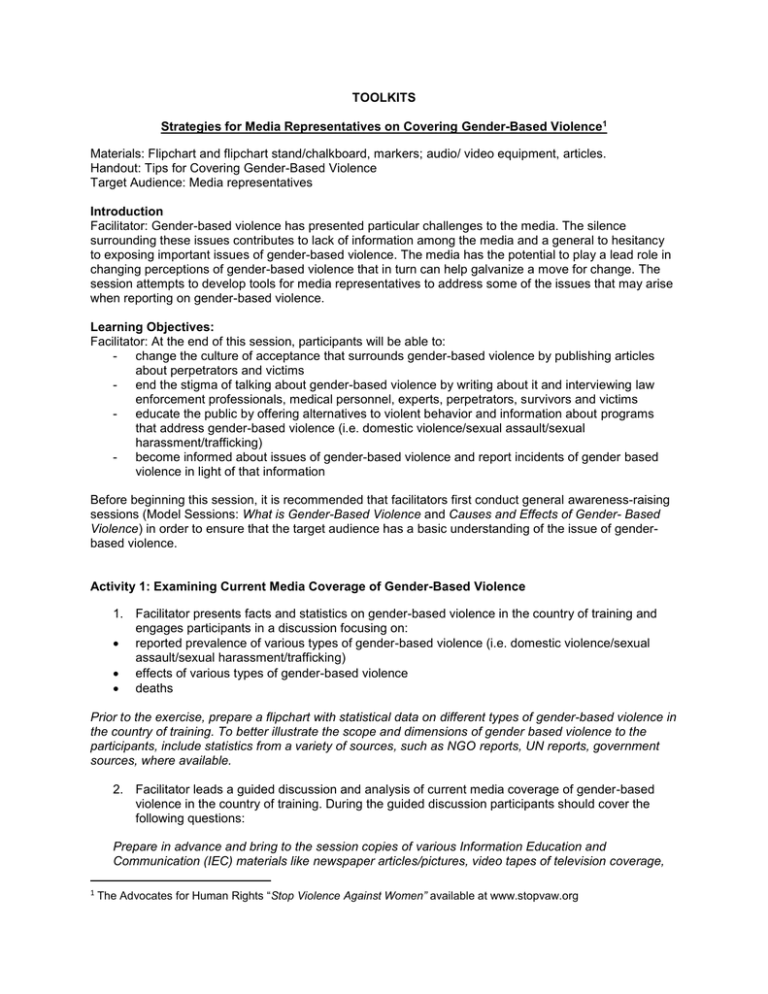
TOOLKITS
Strategies for Media Representatives on Covering Gender-Based Violence1
Materials: Flipchart and flipchart stand/chalkboard, markers; audio/ video equipment, articles.
Handout: Tips for Covering Gender-Based Violence
Target Audience: Media representatives
Introduction
Facilitator: Gender-based violence has presented particular challenges to the media. The silence
surrounding these issues contributes to lack of information among the media and a general to hesitancy
to exposing important issues of gender-based violence. The media has the potential to play a lead role in
changing perceptions of gender-based violence that in turn can help galvanize a move for change. The
session attempts to develop tools for media representatives to address some of the issues that may arise
when reporting on gender-based violence.
Learning Objectives:
Facilitator: At the end of this session, participants will be able to:
- change the culture of acceptance that surrounds gender-based violence by publishing articles
about perpetrators and victims
- end the stigma of talking about gender-based violence by writing about it and interviewing law
enforcement professionals, medical personnel, experts, perpetrators, survivors and victims
- educate the public by offering alternatives to violent behavior and information about programs
that address gender-based violence (i.e. domestic violence/sexual assault/sexual
harassment/trafficking)
- become informed about issues of gender-based violence and report incidents of gender based
violence in light of that information
Before beginning this session, it is recommended that facilitators first conduct general awareness-raising
sessions (Model Sessions: What is Gender-Based Violence and Causes and Effects of Gender- Based
Violence) in order to ensure that the target audience has a basic understanding of the issue of genderbased violence.
Activity 1: Examining Current Media Coverage of Gender-Based Violence
1. Facilitator presents facts and statistics on gender-based violence in the country of training and
engages participants in a discussion focusing on:
reported prevalence of various types of gender-based violence (i.e. domestic violence/sexual
assault/sexual harassment/trafficking)
effects of various types of gender-based violence
deaths
Prior to the exercise, prepare a flipchart with statistical data on different types of gender-based violence in
the country of training. To better illustrate the scope and dimensions of gender based violence to the
participants, include statistics from a variety of sources, such as NGO reports, UN reports, government
sources, where available.
2. Facilitator leads a guided discussion and analysis of current media coverage of gender-based
violence in the country of training. During the guided discussion participants should cover the
following questions:
Prepare in advance and bring to the session copies of various Information Education and
Communication (IEC) materials like newspaper articles/pictures, video tapes of television coverage,
1
The Advocates for Human Rights “Stop Violence Against Women” available at www.stopvaw.org
audio tapes of radio coverage that address specific forms of gender based violence (i.e. domestic
violence/sexual assault/sexual harassment/trafficking).
What drives the media coverage of gender-based violence? What makes gender-based violence
newsworthy?
Emphasize the point that media coverage focuses heavily on the perpetrator and
sensationalizes gender-based violence. Engage media representatives in a discussion of
factors that play a role in selecting topics to be covered- i.e. “what sells papers?”
How are perpetrators portrayed?
How are victims portrayed?
Is gender-based violence mentioned? If so, does coverage include community experts,
prevention and community response?
How is the violence portrayed? As a complete surprise? As an unpredictable or unavoidable
tragedy? As an isolated incident?
What sources are used and how do these sources highlight or obscure important gender-based
violence issues?
Emphasize that a change in source changes the content of the coverage; for example, a
relative will express shock and remorse and say it was an unpredictable tragedy, and ask that
the privacy of the family be respected; a gender-based violence expert will flag patterns of
abuse that led to the murder and focus on the violence as part of a broader social
phenomenon.
What common myths about gender-based violence are present in the coverage?
Highlight the point that frequently the media reinforces the perception that incidents of gender
based violence are isolated cases (e.g. domestic violence murders are often portrayed as
isolated family tragedies) and does not challenge common myths about gender-based violence.
In doing so, media representatives miss opportunities to broaden the public’s understanding of
gender based violence, its warning signs and possibilities for prevention and community
intervention.
Do the reporters ask law enforcement agencies about whether a particular incident of gender
based could be considered a crime under national law?
Do the reporters note the sources’ loyalties when deciding whom to quote?
Activity 2: Tips for Covering Gender-Based Violence
1. Facilitator gives a mini lecture presenting tips for covering gender-based violence in the media.
Facilitator emphasizes the following ideas and allows time for discussion:
Prepare a handout with the tips and recommendations listed below prior to the exercise
Find out what the relationship was between the perpetrator and the victim(s).
Be aware of how source selection influences the story.
Search for patterns of violence and control.
Pay attention to language.
Considering the Interests of Survivors of Gender-Based Violence
Educate people about gender-based violence and why it happens.
Explain the reasons why women appear to “put up with” gender-based violence (i.e. why women
stay in abusive relationships/ environments) and the dangers in leaving.
Consider the safety of the person being interviewed.
Protect children’s privacy.
Correct errors.
Word questions so they are not judgmental.
Don’t focus on sensationalist information (i.e. blood/gore in domestic violence/sexual assault
cases, prurient issues in trafficking/sexual harassment cases etc.)
Don’t assume certain cultures or classes are violent
Activity 3: Preparing Sample Questions to Ask
1. Facilitator leads a brainstorming session to create a list of sample questions to ask in an interview
with a survivor of gender-based violence. Facilitator asks each of the participants to share their ideas
randomly or in turn. The ideas are not criticized or discussed; participants may build on ideas voiced
by others.
Write down each answer as they are offered on a flipchart without any comments, notes or
questions for 5-7 minutes. After discussing the ideas, post the list on the wall so it is visible
throughout the training workshop.
2. Facilitator summarizes the results of the brainstorming and highlights the following sample questions:
What made it hard for you to leave/ end the violent relationship?
If a woman is not ready to leave, what should she do to get ready?
Where did you find help?
Could the police have helped you? Who else would you seek help from?
3. Facilitator follows with a mini lecture examining best media practices from the country of training and
other countries:
Educate yourself on the legislation in your country that addresses gender-based violence,
through interviews with law enforcement, prosecutors, judges and lawyers.
Identify and address common questions and misconceptions.
Put gender-based violence in context.
Shed light on the causes and contributing factors for gender-based violence; warning signs for
gender-based violence.
Be careful of sources who are emotionally involved with the perpetrator.
Avoid quoting distant acquaintances/colleagues.
Compile publishable sample materials on gender-based violence through collaboration with local
victims advocates, service providers, and list references to NGO services and other resources for
survivors of gender-based violence available within the country of training.
Facilitator may want to list types of sample materials on flip chart:
Examples:
o Warning Signs of Domestic Violence
o Suggestions for Helping Someone Who is Facing Domestic Abuse
o Tips for Women and Girls who are Thinking about Working Abroad
o Sexual Harassment: What Can I Do?
This session presupposes that the participants will already have an understanding of the national law
applicable to gender-based violence. If this is not the case, the facilitator should ensure that this
information is covered in this or later sessions.
Activity 4: Role-Play
1. Facilitator divides the participants into smaller groups and distributes role-play scenarios on a specific
incident(s) of gender-based violence, so that each group has to role play a different scenario.
Facilitator assigns roles to the participants (for example, reporters, survivors, perpetrators and other
sources [i.e. police, NGO staff, prosecutors, judges, lawyers, doctors, family]) and gives the
participants 35 minutes to prepare the role-play.
Prepare the role-play scenarios beforehand and write them down on sheets of colored paper
2. After 35 minutes, small groups act out their respective role-plays. Discussion in a larger group
follows.
Summary and Closing:
Facilitator closes, emphasizing the following ideas:
The media is one of the most important socializing influences in people’s lives. Negative and
stereotypical images of women in the media, and the ways in which the media reports genderbased violence (as a lesser crime or violation) contributes to the acceptance of gender-based
violence.
The dominant myth is that the media is neutral and objective. However, each media
representative brings to the coverage his/her views, opinions, believes and attitudes. These
inform the way in which media representatives view a particular issue.
The media does not simply transfer information to society without making judgments. The media
informs our understanding of issues, and therefore has a critical role to play.
Questions and Comments:
Facilitator should end the session by asking if there are remaining questions or comments related to this
material. Keeping track of feedback will allow the facilitator to make useful changes to future
presentations.
Sources:
Rhode Island Coalition Against Domestic Violence, Domestic Violence: A Handbook for Journalists, June 2000.
Inter Press Service, Gender Links, Fighting Violence Against Women: A Training Manual for Journalists.







